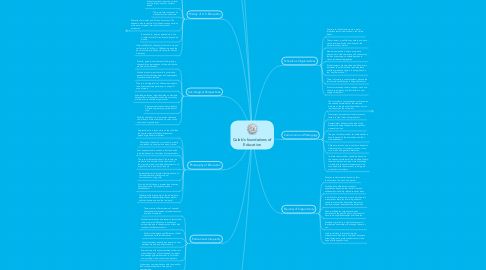Caleb's foundations of Education
von Caleb Adams


1. Caleb Adams
2. Politics of Education
2.1. Education is the deliberate, systematic, and sustained effort to transmit, evoke or acquire knowledge, attitudes, skills or sensibilities as well as outcomes of that effort
2.2. the purposes of education are concerned with the type of society people live in and the type of people we wish to live in it.
2.3. Intellectual purposes of teaching- to teach the basic cognitive skills
2.4. political purpose- to inculcate allegiance to the existing political order
2.5. social purpose- to help solve social problems
2.6. economic purpose- to prepare students for their later occupational roles
2.7. The conservative perspective began in the 19th century and applied the evolutionary theories of Darwin to the analysis of societies. This view looks at social evolution as a process that enables the strongest individual or groups to survive and looks at human and social evolution as adaptation to changes in the environment.
3. Philosophy of Education
3.1. Progressivism is a focus more on the child then the course material. Student interest and personal growth are important.
3.2. Philosophy of education is rooted in practice and stands on its own with no end in mind
3.3. Past experiences are used to reflect and solve problems based on the ideas of progressivists.
3.4. The role of the teacher should be to help the student in and outside of the classroom. to lead, guide, mentor and help the student in all aspects of life in and out of schools.
3.5. Existentialism also stresses the importance of the individual and their emotional commitment to living fully.
3.6. Also, individual choice is greater than theories, history and social institutions based on existentialism.
3.7. I believe in the importance of the individual to help them with the knowledge they need for both the classrooms and the real world.
4. Schools as Organizations
4.1. Structure in school systems are a major important factor in education in the United States.
4.2. The curriculum, qualifications, safety and more must be carried out by the citizens of the particular school district.
4.3. Student composition is becoming more diverse, but at the same time, the nonminority families are moving to suburban areas to create residential segregation.
4.4. School systems are very open and allow every individual to enroll in school and stay there until they graduate. there is a strong belief in the "common school".
4.5. There is diversity in school systems despite the fact toward centralization in the public sector.
4.6. Schools are leaning toward stronger math and science competency and this lead to a new supply of teachers.
5. History of U.S. Education
5.1. Historian Merle Curti said the use of formal schooling for the colonists was to protect freedoms such as though, religion and press which led towards the maintenance of a democratic society.
5.1.1. Project specifications
5.1.2. End User requirements
5.1.3. Action points sign-off
5.2. school was charged with assuming roles that were of the family, church and community.
5.3. Schools continue to serve as a focal point in larger issues of societal needs.
5.4. There are little consensus on motives for school reforms.
5.5. Education for women and African Americans- This opened a whole new door for the education world as more were accepted into schools and private academies.
5.5.1. Define actions as necessary
5.6. Education for women opened up in the middle to late 19th century and expanded quickly.
5.7. Historically Black Colleges did not come around until after the Civil War in 1868 and opened the door for more and better schooling for African Americans.
6. Sociological Perspectives
6.1. Schools, parents, churches and other groups shape children perceptions of the world by the process of socialization.
6.2. Schools play an important role in promoting gender roles with stereotypes and segregation of extracurricular activities.
6.3. Theory is an integration of all known principals, laws and information pertaining to a specific area of study.
6.4. Knowledge plays an important roles on students because the more they know then the more they are likely to use that learning material.
6.5. Employment- students that graduate will lead to greater opportunities for jobs.
6.6. Mobility was linked to a tournament because the "winners" were allowed to move on to the next round or grade level.
7. Curriculum and Pedagogy
7.1. The curriculum of progressivism is focused on the needs and interests of the students because of the idea that the student is more important than the curriculum.
7.1.1. Materials
7.1.2. Personel
7.1.3. Services
7.1.4. Duration

